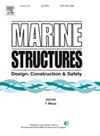G-Twin: Graph neural network-based digital twin for real-time and high-fidelity structural health monitoring for offshore wind turbines
IF 5.1
2区 工程技术
Q1 ENGINEERING, CIVIL
引用次数: 0
Abstract
The development of digital twin (DT) of real-time and high-fidelity structural health monitoring (SHM) is critical for ensuring the structural safety of an offshore wind turbine (OWT) during its service life. However, reconstruction of high-fidelity stress field in SHM faces great challenges because the monitoring stress data from sensors is normally sparse and limited. In this study, a novel graph neural network (GNN)-based DT, named herein G-Twin, is proposed to reconstruct the high-fidelity stress field in real time using sparse monitoring data. In G-Twin, structures of an OWT are represented as graphs, with nodes and edges capturing the structural geometry in a non-Euclidean space. Graph features are designed as the sparse monitoring data and these features are iteratively aggregated and updated through a message-passing mechanism in terms of the local topology of the graph and the high-fidelity stress field is then achieved. Moreover, an enhanced Mixup technique is developed for data augmentation to minimize the prediction errors when the OWT is subjected to the extreme loading. A series of numerical experiments are conducted and the results show that the G-Twin can accurately predict the high-fidelity stress distribution of an OWT in terms of sparse sensor data in real time (the inference time for the G-Twin on a consumer-grade GPU is approximately 0.013 s on average). The proposed G-Twin has demonstrated its great capability and feasibility for DT of real-time and high-fidelity SHM for OWTs.
G-Twin:基于图形神经网络的数字孪生,用于海上风力涡轮机的实时和高保真结构健康监测
实时高保真结构健康监测的数字孪生(DT)技术的发展对于保证海上风力发电机组在其使用寿命期间的结构安全至关重要。然而,由于传感器监测应力数据的稀疏性和有限性,高保真应力场的重建面临着很大的挑战。本研究提出了一种基于图神经网络(GNN)的DT算法(G-Twin),利用稀疏监测数据实时重建高保真应力场。在G-Twin中,OWT的结构被表示为图,节点和边捕获非欧几里德空间中的结构几何。将图特征设计为稀疏的监测数据,根据图的局部拓扑结构,通过消息传递机制对这些特征进行迭代聚合和更新,从而获得高保真的应力场。此外,本文还开发了一种增强的Mixup技术用于数据增强,以最大限度地减少OWT在极端载荷下的预测误差。通过一系列数值实验,结果表明,G-Twin可以根据稀疏传感器数据实时准确地预测出OWT的高保真应力分布(G-Twin在消费级GPU上的推断时间平均约为0.013 s)。所提出的G-Twin方案已经证明了其在wts实时高保真SHM的DT中具有很强的能力和可行性。
本文章由计算机程序翻译,如有差异,请以英文原文为准。
求助全文
约1分钟内获得全文
求助全文
来源期刊

Marine Structures
工程技术-工程:海洋
CiteScore
8.70
自引率
7.70%
发文量
157
审稿时长
6.4 months
期刊介绍:
This journal aims to provide a medium for presentation and discussion of the latest developments in research, design, fabrication and in-service experience relating to marine structures, i.e., all structures of steel, concrete, light alloy or composite construction having an interface with the sea, including ships, fixed and mobile offshore platforms, submarine and submersibles, pipelines, subsea systems for shallow and deep ocean operations and coastal structures such as piers.
 求助内容:
求助内容: 应助结果提醒方式:
应助结果提醒方式:


